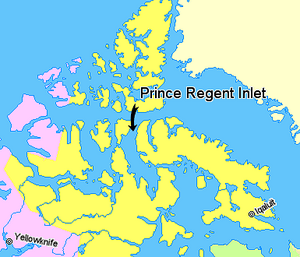Prince Regent Inlet facts for kids
The Prince Regent Inlet is a large body of water located in Nunavut, Canada. It sits between two important landmasses: Baffin Island (specifically the Brodeur Peninsula) on its east side and Somerset Island on its west side. This inlet is part of the vast Arctic region.
To the north, Prince Regent Inlet opens up into Lancaster Sound, which is a major waterway. To the south, it gradually blends into the Gulf of Boothia. The northern part of the inlet is about 40 miles (64 km) wide, while the southern part is wider, around 65 miles (105 km) across. The water here is very deep, and there are no islands within the inlet itself.
Exploring the Arctic Waters
For many years, explorers tried to find a sea route through the Arctic called the Northwest Passage. They hoped this passage would connect the Atlantic and Pacific oceans, making trade routes shorter. Prince Regent Inlet was explored several times during this quest. However, explorers soon realized that the inlet, along with the Gulf of Boothia, was a "cul-de-sac." This means it was a dead end for ships trying to find a way through.
Early Expeditions
In 1819, an explorer named William Edward Parry sailed more than 100 miles (160 km) south into the inlet before he had to turn back. The ice and difficult conditions made it impossible to go further.
Later, in 1829, John Ross also sailed through Prince Regent Inlet. His ship became trapped in the ice in the Gulf of Boothia, and he and his crew were stuck there for four long years before they finally managed to escape.
Discoveries and Challenges
In 1852, another important discovery was made: Bellot Strait. This narrow passage, located to the west of the inlet, was often frozen solid. In 1858, Francis Leopold McClintock attempted to sail through Bellot Strait. However, he also had to give up because of the ice and spent the winter nearby. These expeditions showed just how challenging and dangerous exploring the Arctic could be.
See also
 In Spanish: Estrecho del Príncipe Regente para niños
In Spanish: Estrecho del Príncipe Regente para niños


